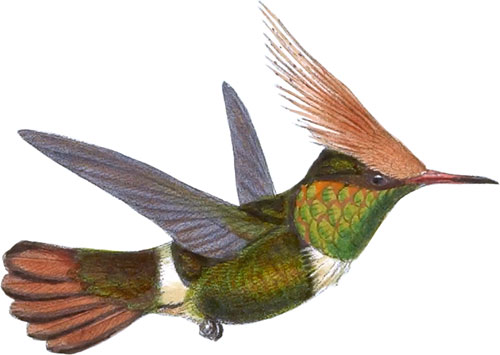The discovery of this beautiful little species of Lophornis is said to have been made by M. De Lalande, the celebrated French traveller, at the period of whose visit to Brazil and for some time afterwards the bird was very rarely to be met with in our collections; such, however, is no longer the case, for its proper habitat having been ascertained, it is killed and skinned by the negroes, and the skins, bearing a certain market value, are sent to this country and to France in great numbers.
Its native country is Brazil; and the localities in which it appears to be most abundant are the provinces of Rio de Janeiro and Minas Geraes. M. De Lalande procured examples in the forests bordering the river Paraiba, to the north of Rio de Janeiro; and MM. Quoy and Gaimard obtained others among the moderately dense vegetation bordering the torrents at the foot of the Organ Mountains. The notes transmitted to me by Mr. Reeves of Rio de Janeiro merely mention that it inhabits that province and Minas Geraes, but unfortunately give no account of its habits.
The nest is a small round cup-shaped structure, composed of a rufous-coloured fungus-like substance, coated externally with cobwebs and fine vegetable fibres, and decorated with small pieces of lichens.
Like the other members of the genus, this species has the sides of the neck adorned with beautiful snowywhite plumelets; but these plumelets differ in form, being shorter and broader, and are moreover crossed by a band of luminous green at the extremity, instead of having a spot of that colour at the tip.
The same difference which exists between the sexes of the other species also occurs with the present, the female being destitute of the conspicuous decorations of the male.
The male has a broad band across the forehead, face and throat luminous green; head and crest dark chestnut-red; upper surface and wing-coverts bronzy green; wings purplish brown; a band of white across the lower part of the back; upper tail-coverts bronzy brown; central tail-feathers bronzy green; lateral ones deep chestnut-red, bordered with brownish black; on each side the neck a series of broad white feathers advancing forward and meeting immediately beneath the green gorget; each of those on the sides of the neck crossed at the tip with a band of luminous green; under surface bronzy green; bill flesh-red at the base, deepening into black at the point.
The female has the head and upper surface bronzy green; a narrow band of white across the lower part of the back; upper tail-coverts tipped with bronzy red; tail deep fawn-colour, crossed towards the extremity by a broad dusky band; throat rufous; under surface bronzy green.
The Plate represents two males and a female with the nest, all of the natural size.
 Lophornis ornatus
Tufted Coquette
Lophornis ornatus
Tufted Coquette
 Lophornis Gouldi
Gould’s Coquette
Lophornis Gouldi
Gould’s Coquette
 Lophornis Regulus
Great-Crested Coquette
Lophornis Regulus
Great-Crested Coquette
 Lophornis Delattrei
DeLattre’s Coquette
Lophornis Delattrei
DeLattre’s Coquette
 Lophornis Reginæ
Spangled Coquette
Lophornis Reginæ
Spangled Coquette
 Lophornis Helenæ
Princess Helena’s Coquette
Lophornis Helenæ
Princess Helena’s Coquette
 Lophornis adorabilis
Salvin’s Coquette
Lophornis adorabilis
Salvin’s Coquette
 Lophornis pavoninus
Roraima Coquette
Lophornis pavoninus
Roraima Coquette
Featuring all 422 illustrated species from John Gould’s A Monograph of the Trochilidæ, or Family of Humming-Birds arranged by color.